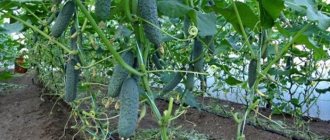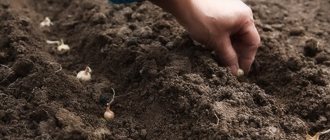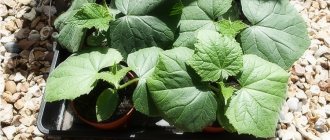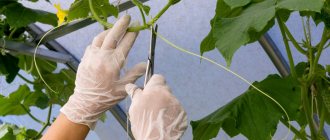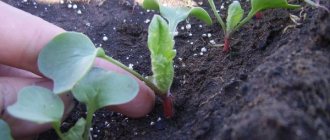We are all accustomed to growing radishes in the spring; this is almost the very first vegetable root crop that ends up in our salads, but not many people know that radishes can be cultivated no less successfully in the autumn. However, the agricultural technology for growing vegetables during this period is somewhat different from the spring one. Let's take our time to figure out what needs to be done correctly to achieve high yields of autumn radishes.
Radishes grown in autumn
The benefits of growing radishes in the fall
Several advantages of growing autumn radishes: firstly, root crops can be stored in the beds longer in the fall, therefore, they retain their marketable qualities longer. You don’t have to rush into cleaning until the real cold starts. Secondly, even if you are a little late with harvesting, radishes, which are rightfully considered a very cold-resistant crop, will perfectly tolerate frosts even a couple of degrees below zero. Therefore, due to the low temperatures that often occur in September and October, there is no need to worry too much. And another advantage of autumn planting is salvation from the cruciferous flea beetle. As you know, this is almost the most terrible pest of radishes; in this case, in the fall, due to the cold, it may not manifest itself (but not 100%, of course), so the harvests will be intact, and chemicals should be used to protect against it no need.
Reviews from gardeners
I really liked the Zhara variety, very early, 18 days. I planted it at the end of August, when we already had continuous rains and cold, the tops were small, and the root crop grew very decently and really quickly, next season I will only plant it.
charodey
https://www.forumhouse.ru/threads/298380/
I tried to plant radishes in the middle of summer - they grew into shoots. It turns out that he needs a certain daylight hours! I sowed it in August and forgot about it, but in September I came across it and gasped! Huge, beautiful, delicious!
Natasha
Conditions for growing autumn radishes
Naturally, to get a good and tasty autumn radish, it needs plenty of water in the soil, an abundance (or rather, moderate abundance) of light and, of course, food in the soil. As for temperature, radishes are not picky and will grow quite normally at +17-19 degrees. Light? It’s also not particularly important: at this time the day is usually already short, this is even to the benefit of the radish, because when the length of daylight hours is more than 13 hours, the radish seems to forget that it needs to grow root crops, it grows the above-ground mass, instantly forms flower stalks and strives quickly form pods with seeds. You should not think that by sheltering the radishes from the sun, simply hiding them in the shade, you can save the situation; in the shade, the radishes will wither and actually do not form root crops.
As for the soil, quite fertile and light loams with slightly acidic reactions, that is, when the pH is 5.5-7.0, are considered simply ideal for autumn radishes. On more acidic soils, radishes almost always suffer from clubroot.
Important ! If you plan to grow radish varieties with elongated root crops, like carrots, then be sure to prepare the soil well; its arable horizon should be perfectly cultivated up to 20 cm.
A prerequisite for obtaining a good radish harvest is sufficient soil moisture. It is clear that in early spring moisture will be provided by melted snow, but in the summer you will have to water it yourself. If there is little moisture in the soil, then the radish will, although it will form root crops that will be typical in shape and color, but they will turn out to be completely unpleasant in content: they will be rough, lacking juice, bitter, and if there is very little moisture (which happens in dachas) ), then you may not get the typical “radish” shape. It is also not worth watering the soil in portions (sometimes thick, sometimes empty), this will affect the root crops with ordinary constrictions, sometimes very noticeable.
Watering
Radishes love moisture. If the soil dries out even for one day, the harvest will lose quality, the roots will become tough and bitterness will be added. Therefore, you need to water often, usually once every few days, but it is important to check the soil moisture at the level of the roots; it happens that watering is carried out daily, and if the sun is warm, then a couple of times a day. That is, you need to water as needed. But the conditions of a polycarbonate greenhouse contribute to an increase in overall humidity, which is fraught with rotting or the appearance of fungal diseases. Therefore, mandatory care includes ventilation for at least 10 minutes after each watering.
When to sow autumn radishes?
Typically, large-fruited radish varieties, distinguished by mid-ripening and late-ripening, are best sown at the very end of July or in the first half of August. Then you will create root vegetables that are not only tasty and proper, but also quite shelf-stable. If you still have nowhere to store them, and you will eat them, as they say, “from the garden,” then you can sow autumn radishes closer to the end of August or even when schoolchildren go to school, of course, if the autumn is warm and not It will be scary with early frost and snow.
Advantages of a greenhouse
Radish in a greenhouse
Growing radishes in a greenhouse is becoming popular in regions with a wide variety of climates. And this is quite logical, because it has many advantages over growing crops in open ground.
- The greenhouse allows you to grow radishes all year round. Even in winter, many gardeners grow it for personal consumption and sale.
- In a greenhouse, productivity increases if you choose the right variety.
- Climate conditions can be controlled or at least slightly adjusted.
- Strong winds, cold snaps, night frosts in early spring and other disasters do not threaten the harvest.
- Radishes grow faster in a greenhouse than in open ground.
- With proper care, radishes from a greenhouse turn out just as tasty, large and beautiful as those from the open ground.
Soil preparation
For autumn radishes, no gardener will definitely keep a clean and tidy garden bed for half a season; there is definitely something growing on it. Radishes are like secondary housing, so you need to remember what was in this place before.
Autumn radishes will grow well in a bed where garlic, cucumbers, early potatoes, peas and beans, as well as tomatoes previously grew. As you can see, the set is large; in fact, after any crop that has managed to escape from the garden by this point, you can sow autumn radishes. However, there are also completely undesirable predecessors - these are radish, daikon, cabbage, horseradish and watercress, in general, all representatives of cruciferous vegetables, because they quickly accumulate common diseases and enemies, which are perfectly transmitted through the soil.
Personally, I would not recommend sowing autumn radishes in an area where other root crops had previously grown, it was such a negative experience.
As for preparing the soil, you can’t hesitate here, summer is fleeting, immediately after harvesting the previous crop you need to dig up the soil, removing all weeds and plant debris, and add 25-35 g of ammonium nitrate, 25-35 g of superphosphate and 35 g of sulfate for digging potassium, I would recommend in dissolved form and this, naturally, per square meter of bed.
If the soil on the site is completely poor and depleted, then it is advisable to add humus or compost; usually a bucket per square meter is enough.
After digging and applying fertilizer, the soil needs to be loosened very well; ideally, it should be loose to a depth of 18-22 cm, but this depends, of course, on the type of radish that you will use. If you plan to sow long-fruited varieties, then it is advisable to increase the depth of cultivation (loosening). After complete tillage of the soil, it is necessary to irrigate, preferably by sprinkling.
Autumn radish shoots
Features of sowing autumn radishes
Unlike spring, summer-autumn sowing of radishes is carried out a little sparser, always taking into account the final size of the root crops of the sown variety and counting on their maximum illumination by the sun during a short day.
Let's give an example: for example, for large-fruited radish varieties, it is desirable that the tape have from eight to ten lines, while the distance between the lines in the tape is better to be 12-14 cm, between seeds in rows - 6-7 cm, and between the tapes themselves - 40-45 cm.
The standard sowing rate for autumn radish seeds is approximately one gram per square meter. You can have a little (10-15%) more (if not everyone knows, let’s clarify: a gram of radish seeds contains up to 120-125 pieces, sometimes more).
The ideal time to plant radishes is when the weather is damp and fairly cool; if there is drizzle, then the weather itself is helping you. Before sowing, while waiting for drizzle, soak the seeds for 12 hours (usually overnight) before planting them in the ground.
When everything is ready, we go out to the garden bed, make grooves in it after 12-14 centimeters, lightly compact the bottoms of the grooves with our fingers and then water them with water, preferably from a spray bottle, after that we place them at a distance of about 5-7 cm (a lot depends on the type of radish here). seeds and carefully so that they do not move, sprinkle with soil. It is this kind of sowing that can protect the soil longer from the formation of a soil crust, through which it will be difficult for a sprout to break through.
Important ! Plant radish seeds to a depth of one and a half to three centimeters. The depth depends on the soil: on dense soil 1.5 cm is enough, on loose and sandy soil - 2.5-3 cm, no more. If you place radish seeds very deeply, this will delay the emergence of seedlings: the above-ground mass breaking through to the top may come out later. But trying to go deeper (if planted shallowly), the root crop may end up looking ugly.
If we are not talking about a couple of acres, but about a large area that you want to occupy with autumn radishes, then it is better to calibrate the seeds before sowing them in the soil. Although this task is not quick, it will still be more convenient to plant each faction separately. Special sieves for seeds can speed up the situation; they divide the seeds into fractions - about 3 mm, from two to 2.5 mm and less than two millimeters in diameter. By sowing each calibrated fraction separately, you will get more uniform seedlings and much more even crops of autumn radishes.
Naturally, everything does not end with sowing radishes into the soil; almost no less important work begins - caring for the seedlings and growing plants until harvesting. Maintenance usually includes watering, protection from diseases and pests, harvesting and preserving it.
Caring for autumn radish crops
In addition, do not forget about periodically, at least once a week, loosening the soil between the rows of radish crops, carrying out a series of fertilizing, watering, thinning out the emerging seedlings, and, as we have already said, controlling pests and diseases.
So, even before the radish shoots appear, you need to be on your guard; you need to mercilessly fight the soil crust by any means to eliminate it. Typically, the soil crust appears after rain or watering, usually abundant. The risk of soil crust formation can be somewhat reduced if the beds are mulched with very fine sawdust or river sand after sowing radish seeds and watering the soil. The slightest loosening helps, when the soil layers remain in place, as well as watering from a spray bottle, great if with rainwater.
If all is well, radish seedlings usually appear within four days; in rare cases, you will have to wait a little longer - up to seven days. Know that the seedlings may not be able to withstand the rays of the scorching sun, so at least for a couple of days, shade them from the sun. They will not tolerate excessive soil moisture, so water for three days only with a spray bottle, and around this time you can begin normalizing the crops.
Thinning radish crops
You should not skip thinning the seedlings, since this is very important when growing autumn radishes. Thinning helps improve lighting of the plantation, increases the feeding area of each individual plant, and accordingly increases the overall yield from the site.
It is usually advisable to start thinning the root crops of autumn radishes a week after sowing. If they are developing very actively, then a day or two earlier, but you shouldn’t rush too much. It is necessary to achieve the emergence of truly massive seedlings and high-quality development of plants. Before thinning, the soil needs to be watered; it is better to do this with a spray bottle, moistening the soil by 2-3 cm.
Next, excess competing plants are simply pulled out of the ground carefully so as not to affect those located nearby. As a result, between the radish seedlings, depending on the variety, there should be a free distance of four or five centimeters. Next (after a couple of days), housewives usually select some radishes to use for food and thereby increase the distance between plants to eight or even ten centimeters. It is important to carry out uniform sampling so that the distance between plants is uniform.
For an example, based on my own experience (we will definitely describe radish varieties at the end), I can say that the optimal standing density, say, for the Dungansky radish variety is about one hundred plants per square meter, for the Red Giant and Zenit radish varieties - less, about eighty or ninety pieces, and the earlier ripening varieties, of course, can be sown even thicker.
It is clear that even after thinning, the area in which radishes grow should be moist, loose, and free of weeds. This can be partially achieved by mulching: the same humus in a one-centimeter layer.
Thinning radish plantings.
Watering and fertilizing radishes
Having briefly mentioned watering and fertilizing, let’s now talk about them in more detail. So, we all know well that radishes are demanding of moisture, especially when their root crops begin to form. Watering with a hose is not an option - you can wash away the soil, expose the root crops and pests will attack them. The best thing is to arm yourself with a watering can with small nozzles, this way you won’t wash out the soil and won’t damage the seedlings (you won’t break the foliage, press it to the ground, etc.).
If there is no natural moisture in the form of rain and it’s hot outside, then you need to water every three days, and if it’s really hot, then every two days. On light and sandy soils, you can water at least every evening, as long as the soil has time to dry out by the next evening. For those who like numbers, we can say that the watering rate for radishes is about 7-14 liters per square meter, depending on the plant variety, soil composition, its nutritional value, the presence of moisture in the form of rain, and other things.
Watering radishes must become a habit, become a regular, routine thing, otherwise the root crops may grow, but they will be bitter, even completely inedible. If there are changes in watering - for example, you haven’t been at the dacha for a long time, you came and flooded all the radishes, turning the beds into a swamp, then in addition to the constrictions that we wrote about above, the root crops can simply crack and begin to rot (also not an option, you know...) .
Feeding - this section is criticized in any article and, probably, will always be criticized. If you live well without fertilizers, then don’t add anything and... period. And those who understand that everything living, from humans to radishes, must eat, need to know more about feeding. So my personal suggestion is slurry. You need to dilute it 8-10 times with water, add 20-25 g of superphosphate and 10-15 g of potassium sulfate (not chloride or potassium salt) to the solution (usually in a bucket) - this is the norm for 2-3 square meters of bed. If it seems to you that your plants are developing significantly worse than your neighbor’s, then you can add one fertilizer with ammonium nitrate. Just dilute one gram of it in a bucket of water and water every square meter of soil in the area.
Of course, nitrogen fertilizers are not a panacea, I myself have always said, I say and will continue to say that it is impossible to abuse them, it is prohibited, it is contraindicated: in addition to the fact that instead of root vegetables they can stimulate the plant to form green mass, they will also have radishes inside ping pong ball: seemingly solid, but empty inside. After harvesting, such root crops usually begin to quickly deteriorate and simply rot. Well, yes, yes, yes (!): nitrates - they accumulate and cause harm to the human body (although, in my opinion, one walk along Tverskaya at rush hour is equal to a kilogram of eaten radish roots with a bunch of nitrates).
Control of radish diseases and pests
With watering, fertilizing and loosening the soil, which some individuals even do with combs and toothpicks, we forgot about diseases and pests, and the good neighbor did not try and exterminate them while we were arguing about the “benefits” of nitrates.
As we already mentioned in this article, one of the most dangerous pests for radishes is the cruciferous flea beetle. Yes, she is not so active during this period of time, but it cannot be said that she is inactive at all. There have been cases when you believe such promises, you go out to an area where only yesterday there were friendly and cheerful shoots of autumn radishes, but they are completely gone. Therefore, it is better to overdo it. Do you know what this flea does? It eats away a sweeter, more nutritious and important, it seems, both for it and, of course, for the plants themselves, growth point, and if the weather is dry and hot, then you definitely need to be ready.
Fighting cruciferous flea beetles
Nobody recommends using chemicals to control cruciferous flea beetles. We take the most terrible allergen, having previously put on protective gloves and a respirator - mustard and carefully, a very tiny pinch, sprinkle the rows of radishes. You can also use hot ground pepper, and you need a maximum of a teaspoon of mustard and pepper per square meter. After this, the crops need to be covered with a non-woven covering material, creating something like a greenhouse with a chemical attack on flea beetles.
An original way to protect radishes from cruciferous flea beetle:
About seven days before sowing radishes in the ground, it is necessary to sow watercress and mustard, and after another seven days, sow radishes in the rows of these crops. We act like Sherlock Holmes: the flea attacks the seedlings of competitors, we treat them with approved insecticides, strictly following the instructions on the packaging, and kill them, after which we just have to wait for the radishes to sprout and cut off the plants we don’t need that serve as bait. This method may well help, you can try it.
Cabbage fly
They say the cabbage fly is a terrible coward, and if you plant celery next to the garden bed (usually on its periphery), then it certainly will not come close to the areas of your radish.
Kila
As we already mentioned, acidic soils can be dangerous for radishes due to clubroot damage. If you are able to determine the pH of the soil or know that it is definitely acidic, then before sowing we recommend adding 150-200 g of chalk, 250-300 g of lime or 250-350 g of dolomite flour to the soil, of course, calculated per square meter and , ideally, for a year, but it is possible at least a month before sowing the radishes. Wood ash is a good soil deoxidizer; among other things, it contains up to 5% potassium and a fairly large composition of microelements, although in small quantities. Wood ash can be sprinkled in a millimeter layer directly into the base of the hole, and radish seeds can be sown on top.
Overgrown radish
Harvesting
When harvesting, they are guided by the ripening period of the selected variety. It is not recommended to delay with it, as overgrown root vegetables risk becoming hard.
Radish harvesting is carried out as follows: vegetables are watered in the morning, and collected closer to lunch. Then the tops are cut off, but not at the root, but leaving tails 1 cm long. After cutting the tops, the radishes are washed from dirt and dried.
Storage
After drying the radishes, they are stored.
There are two storage methods:
- In plastic bags in the refrigerator for a month.
- In the cellar. To do this, the crop is placed in boxes, the bottom of which is covered with polyethylene. Root vegetables are sprinkled on top with a mixture of peat and sand. This method prevents radish rotting and is more suitable for long-term storage than the first.
Autumn radish varieties
Well, of course, the key to success is determining the correct degree of ripeness of the radish root crop. To do this, you need to know what you are sowing on the plot, that is, the variety and the duration of its maturation from the emergence of seedlings to the production of edible root crops. We have prepared for you a list of radish varieties that have performed best, especially when sowing in autumn.
Typically, these radish varieties are suitable for sowing in August, are ready for harvesting in a maximum of two months and produce fairly large root crops, reaching hundreds of grams. Such root vegetables can be stored in the cellar for up to six months.
- Autumn giant - only 26-28 days pass before it is harvested, the root crops reach a mass of 145 g, they are white, elliptical in shape, with juicy pulp and excellent taste. They can be stored for up to one hundred days.
- Red giant - approximately 52 days pass before harvest, root crops reach a length of 11-13 cm. The variety gives a yield of 3.3 kg per square meter. Very tasty and can be stored for up to 120 days.
- Dungan - about 55 days before harvest and almost the same average weight of the root crop (35-45 g), with a yield of up to 3.5 kg per square meter. The root vegetable of this radish has an excellent taste.
- Zenith - from 31 to 39 days before harvesting, the color of the root crop is pink-crimson, cylindrical in shape, up to 15 cm long, and about three centimeters in diameter. Maximum weight 75 g, sometimes slightly raised above the soil surface. The pulp is interesting - it is very dense, white in color and has a pungent taste. Productivity up to three kilograms per square meter. Capable of long-term storage.
- Saxa - 31 - 35 days pass before harvesting. The color of the root vegetable is red-crimson, oval in shape, diameter up to four centimeters, weight no more than 30 g. The pulp can be either snow-white or pinkish, very dense, a little sharp. From a square meter you can dig up to one and a half kilograms of radish of this variety.
- Würzburg - usually 33-36 days pass before harvest. The color of the root vegetable is red-crimson, it has a round shape and a diameter of about four centimeters with a weight of 15-16 g. The pulp is usually snow-white, but can also be white-pink, the taste is slightly pungent. From a square meter you can harvest almost two kilograms of crop.
- Heat - the first harvest of this variety can be harvested within a month after germination. The color of the root crop of this radish is red-crimson, the shape is either round or oval, and the diameter reaches 3.5 cm with a mass of about three tens of grams. The pulp can be either snow-white or pinkish, quite dense with a slightly pungent taste. You can harvest up to 2.5 kg of crop per square meter.
- Rizenbuter - this variety can be grown at atypical times both in open ground, where it is ready for digging in 24-26 days, and in protected ground, where it takes about the same amount of time. As a result, a red root crop is formed, round in shape, with a diameter of about ten centimeters. The average weight of the root crop is about 35 g. The pulp of this radish variety is snow-white, very juicy and sweet.
- Well, in conclusion, my favorite radish variety is Queen Margot - less than a month passes from germination to digging it up, this variety produces round-shaped root crops, weighing just over 23 g. The pulp is white as snow, quite dense, crispy when consumed, very juicy and, as they say, scientists, “chocked” with vitamins. Interestingly, the germination rate of seeds of this variety always approaches 100%.
So, as you understand, growing autumn radishes is just as easy as spring ones, and given that they are stored quite well, you will be enjoying their fresh root vegetables for a long time.
How to properly plant radishes in a polycarbonate greenhouse on snow
Some experimenters who love a very early spring harvest sow radishes before winter in an unheated polycarbonate greenhouse, having previously prepared the land in the fall and disinfected the greenhouse itself. Their reasoning is clear - if the beds with radishes, sown in dry and cooled to -3 ° C soil, are covered with dense agrofibre, and when snow falls, also with it, then there is a very high chance that the seeds will not freeze.
There is a danger that during prolonged winter thaws they will begin to germinate. But if you open the greenhouse windows in time, remove the insulation, that is, somehow lower the air temperature, then the seeds will not begin to grow at the wrong time.
Usually, for pre-winter sowing, seeds that are unspent from open packs during the season are used, because without packaging they quickly reduce their quality. When sowing on snow, seeds are used that do not raise doubts about their germination. In late autumn, be sure to prepare the beds, fertilize the soil, or even change the top layer.
The ground, before it freezes, needs to be compacted; the piled snow up to 5 cm thick is also compacted. A passage is left between the ridges, which is usually not covered with snow. Sowing on snow is carried out when the air temperature in the greenhouse rises to positive values during the day and the absence of severe frosts at night. That is, the snow should begin to melt during the day. Seeds are sown either in a loose manner, which requires additional thinning, or the seed sowing locations are marked directly on the surface of the snow with a marker.
By the way, you can thin out crops only by breaking or cutting off the sprouts, and not by pulling them out. Radishes really don’t like it when their roots are disturbed. After sowing, the snow beds are sprinkled with a thin layer of sand and covered with agrofibre. If, after the first shoots appear, frost strikes again, it will be urgent to install an arc frame over the beds and stretch two layers of transparent film over it, or apply temporary heating.

